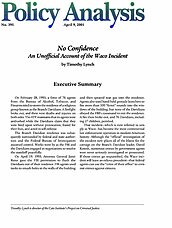On February 28, 1993, a force of 76 agents from the Bureau of Alcohol, Tobacco, and Firearms tried to storm the residence of a religious group known as the Branch Davidians. A firefight broke out, and there were deaths and injuries on both sides. The ATF maintains that its agents were ambushed while the Davidians claim that they were fired upon without provocation, feared for their lives, and acted in self-defense.
The Branch Davidian residence was subsequently surrounded by federal and state authorities and the Federal Bureau of Investigation assumed control. Weeks went by as the FBI and the Davidians engaged in negotiations to resolve the standoff peacefully.
On April 19, 1993, Attorney General Janet Reno gave the FBI permission to flush the Davidians out of their residence. FBI agents used tanks to smash holes in the walls of the building and then sprayed tear gas into the residence. Agents also used hand-held grenade launchers to fire more than 350 “ferret” rounds into the windows of the building, but none of the Davidians obeyed the FBI’s command to exit the residence. A fire then broke out, and 76 Davidians, including 27 children, perished.
That incident–which is now referred to simply as Waco–has become the most controversial law enforcement operation in modern American history. Although the “official” investigation of the incident now places all of the blame for the carnage on the Branch Davidian leader, David Koresh, numerous crimes by government agents were never seriously investigated or prosecuted. If those crimes go unpunished, the Waco incident will leave an odious precedent–that federal agents can use the “color of their office” to commit crimes against citizens.

This work is licensed under a Creative Commons Attribution-NonCommercial-ShareAlike 4.0 International License.

